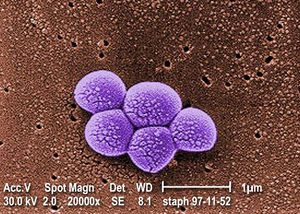Clostridium botulinum Neurotoxin: The Duality of a Microbe with Fatal and Therapeutic Applications
Section

By Firtnam Lastname
At right is a sample image insertion. It works for any image uploaded anywhere to MicrobeWiki.
The insertion code consists of:
Double brackets: [[
Filename: PHIL_1181_lores.jpg
Thumbnail status: |thumb|
Pixel size: |300px|
Placement on page: |right|
Legend/credit: Magnified 20,000X, this colorized scanning electron micrograph (SEM) depicts a grouping of methicillin resistant Staphylococcus aureus (MRSA) bacteria. Photo credit: CDC. Every image requires a link to the source.
Closed double brackets: ]]
Other examples:
Bold
Italic
Subscript: H2O
Superscript: Fe3+
Sample citations: [1]
[2]
A citation code consists of a hyperlinked reference within "ref" begin and end codes.
To repeat the citation for other statements, the reference needs to have a names: "<ref name=aa>"
The repeated citation works like this, with a forward slash.[1]
Section 1
Include some current research, with at least one figure showing data.
Propionibacterium acnes is a gram-positive, fairly slow-growing aerotolerant bacterium. This bacteria is typically linked to the skin condition acne vulgris, commonly known as skin acne. This species is daily commensal and highly present on healthy skin epithelium. Little is detected on the skin of adolescents, specifically those pre-pubescent. This bacterium lives on fatty acids in sebum secreted by hair sebaceous glands in hair follicles. It can also be found in the gastrointestinal biome.
Section 2
Include some current research, with at least one figure showing data.
Section 3
Include some current research, with at least one figure showing data.
Section 4
Conclusion
References
Authored for BIOL 238 Microbiology, taught by Joan Slonczewski,at Kenyon College,2024
